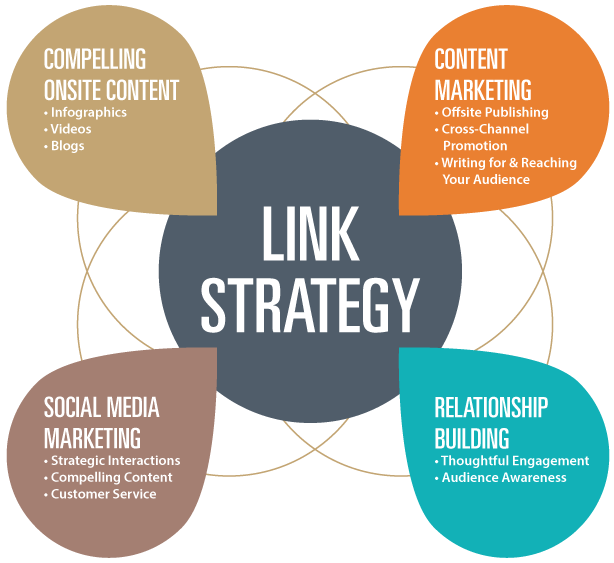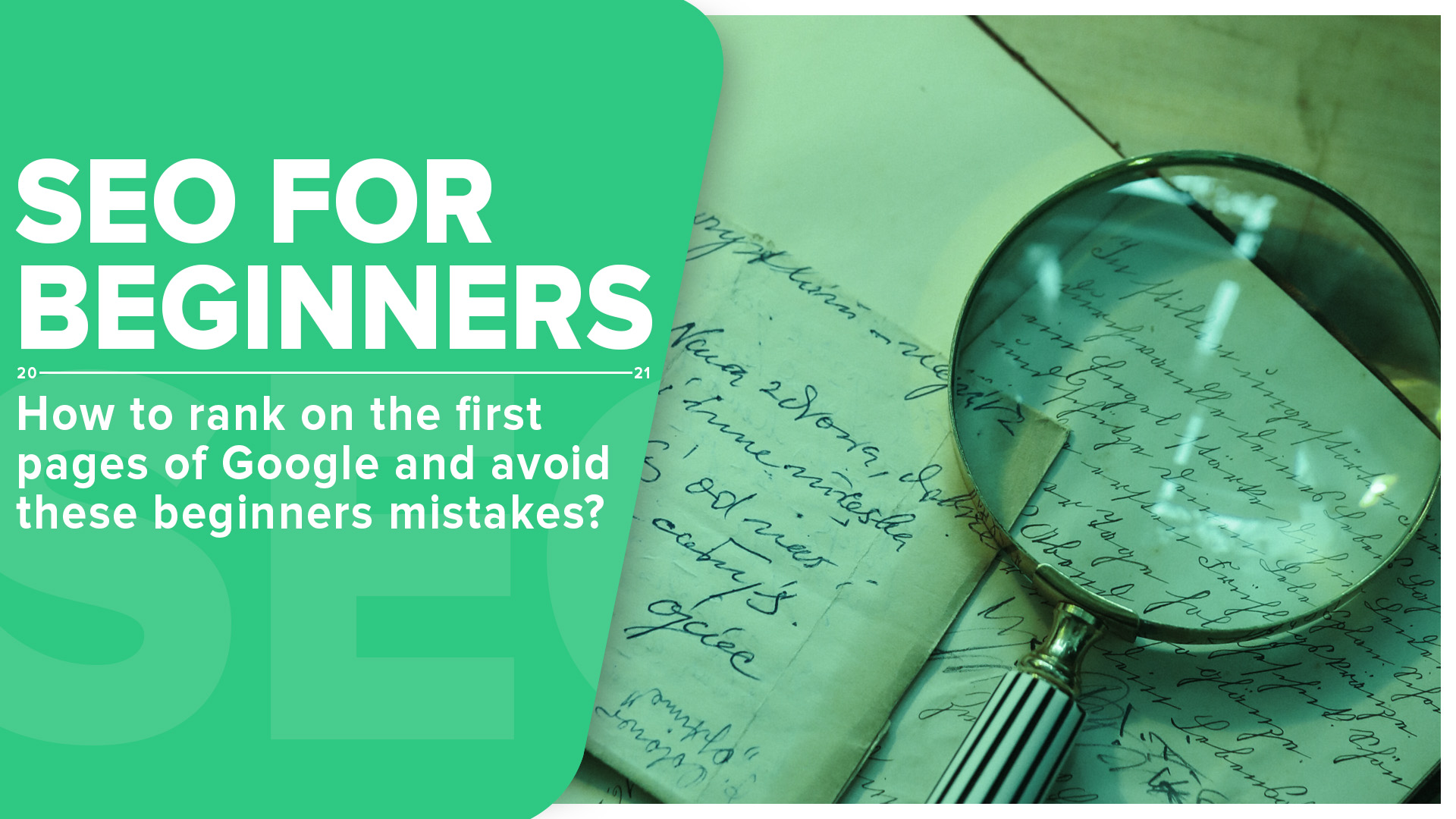
Every business thrives to get more traffic, more leads, and most importantly more sales.
Generating traffic through paid media is easy, simply keep throwing more money and see how people are coming to your site.
However, this is insufficient long-term unless you have deep pockets and can fuel traffic like this for years.
It’s a poor strategy for several reasons:
- Once you stop paying for ads, your traffic suddenly falls to 0 and you get back to the starting point
- It’s hard to make this traffic stick longer on your site that simultaneously returns in the future
Well, there’s no easy answer here, though search engine optimization or better known as SEO could be a great companion to developing your long-term strategy. That generates organic traffic to your site.
Today we’ll get back to basics learn SEO for beginners and why it’s important to your business.
We’ll try to understand how the search engines work and how your website is ranked on Google.
What are the 2 different ways to optimize your website, and what’s the difference between them?
How to measure SEO optimization’s success and what metrics to track?
And lastly, we’ll share our top tools that’ll help you to get started optimizing your SEO at no cost!
SEO Basics
What is SEO?
Search Engine Optimization (SEO) is a process of optimizing your website to rank higher on search engines such as Google.
Different from traffic generated by ads, SEO draws organic traffic to your site. It’s a long-term optimization strategy that won’t deliver instant results and you’ll have to wait months before getting the first results to see the change and traffic increase.
On the other hand, paid media delivers quick results and instantly drives traffic to your site. The problem is that once you stop paying for ads, traffic stops. As a result SEO optimization is a long-term strategy that delivers constant traffic in the years to come.
Why it’s Important to Your Business?
Each day so much new content is created that it becomes very hard to stand out in the crowd and get attention. As a result, SEO optimization can’t be ignored and it’s beneficial for the following reasons:
- Ranking higher in search engines = more traffic – according to IMPACT data, the first 5 organic search results on Google accounted for a total of 67.6% traffic. And you want to be among those 5 positions, otherwise, you lose on so much traffic.
- 24/7 Traffic – different form paid media traffic, optimized content brings free traffic 24/7 and doesn’t end when you stop paying for ads.
- Targeted traffic – differently from other traffic sources such as social media, traffic from search engines is more targeted. Just think for a second. a person scrolling on Facebook or Instagram out of boredom probably is not in a buying mood. Neither interested to buy your products. On the other hand, someone searching on Google has already buying intentions and is more predictable. Which one is more valuable do you think?
- Trust – is an important factor that helps your business to transform traffic to your customers. And being on the first page of Google gives your business a badge that people can trust.
- Brand awarness – according to WebFX data, only 25% of searchers visit the 2nd-page on Google. Without a doubt, you want to be on the 1st-page On Google and don’t miss out on that much traffic.
- More backlinks – according to IMPACT data, websites ranking in 1st place have 3.8 times more backlinks than the sites in 2nd spot. Hence, backlinks still matter, and if you want to reach top-ranking positions, invest time building your strategy.
How do Search Engines work?
When do you start learning something new you begin from the basics, right? And rarely jump into the basketball court to play without even knowing how to dribble first, right?
That’s the same with SEO, and you should start from the basics. Learn how search engines work and how content is ranked.
Knowing the basics will help you to better understand the search queries even if you’re still a beginner.
Did you know that Google processes around 63,000 search queries every second?
To understand how search engines work we need to discuss the following 2 principles:
- Crawling & Indexing
- PageRank
Crawling & Indexing
It’s a complicated process performed by search engines that collects more information about your website and its purpose.
In a nutshell, Google’s spiders (aka bots or crawlers) go through your site. Following one link to another creates a large network of all connections on your site.
In meantime, try to understand as much as possible about your website and its purpose. It scans images, identifies keywords, and what websites link to your site.
All this information is collected and put into an index among the rest of the sites.
Imagine this process as collecting contacts in your phonebook. And having all the important information about every business, contact,s and more in one place.
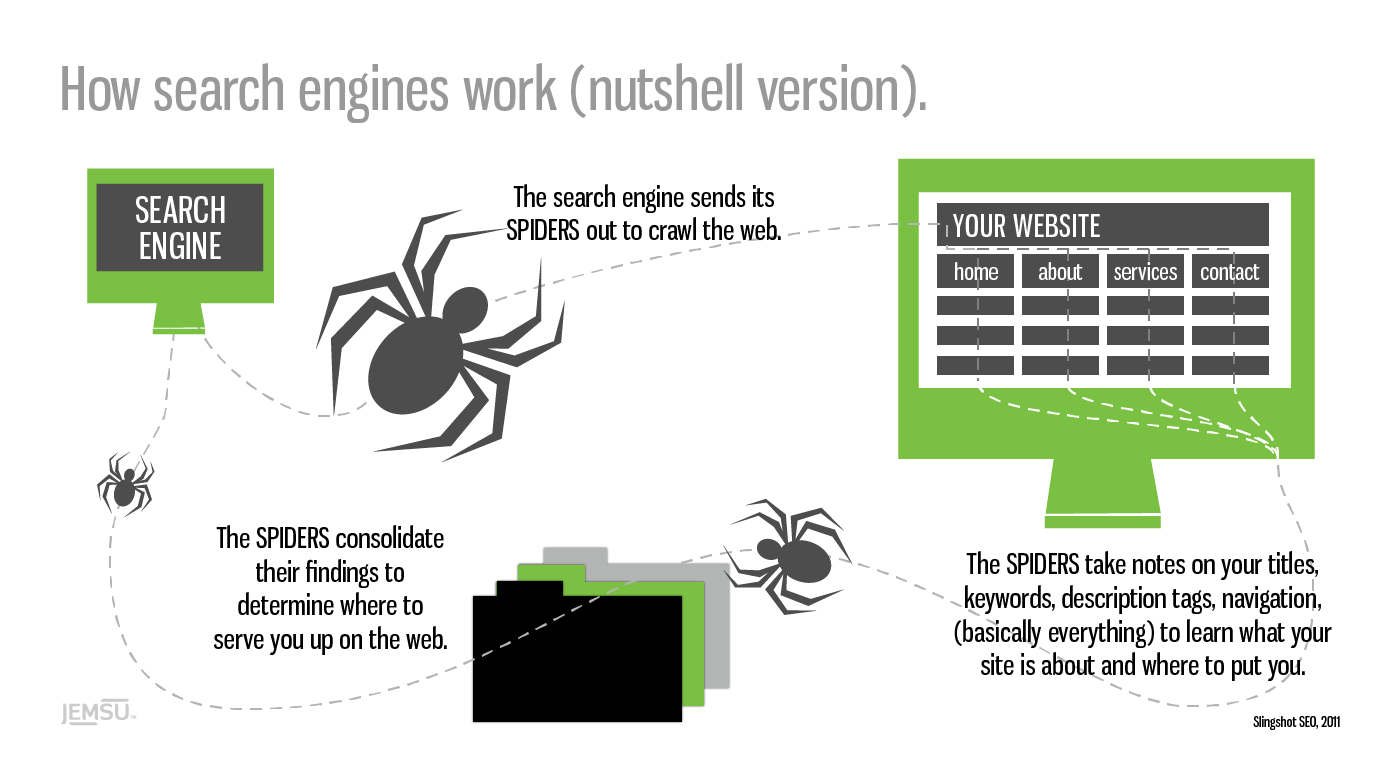
(How search engine works | Neil Patel Blog)
PageRank
Back in 1996, the original Google algorithm was created by its founders Larry Page and Sergey Brin. At this early stage, the algorithm wasn’t that complicated yet and had only a few rules to rank websites. However, within the years this ranking algorithm became more sophisticated and complicated.
Despite many unsuccessful tries to decrypt this code, Google’s ranking remains top-secret. But it’s believed that it takes into account around 255 rules before it makes the final decision.
In addition, the initial code was created by humans, but recently an AI tool called RankBrain was developed which was meant to assist the basic code.
Despite Google keeping its code top-secret, it’s known that the following elements influence the ranking:
- Mobile-Friendliness – back in 2020 Google announced a policy change that encouraged websites to prioritize their site’s optimization to mobile-first. Hence that meant that no longer it’s enough for your site to run smoothly on desktop but it should run fast on mobile too.
- HTTPS & SSL – Google doesn’t like spammy and shady-looking websites, and its security plays an important part in the ranking. Having a small lock next to your site became like a new norm and websites willing to climb higher on search engines needed to get SSL and HTTPS certificates.
- Page Speed – 2 to 5 seconds, that’s the ideal time your website should take to load, but on average websites load time is around 10.3 seconds on desktop. That’s almost 3 times longer than the set norm. It’s not a top secret that Google puts a lot of emphasis on the website’s speed and usability.
- Backlinks – a total amount of website links to your site doesn’t play that important role in getting higher positions on Google anymore. Because over the years link-building rules were abused by sketchy sites and various other black hat SEO techniques were developed. However, it still plays a role in ranking, but now Google prioritizes high-quality links and ignores low profile, sketchy ones.

(How PageRank works | Wikipedia)
Sitemaps
Sitemaps are collection lists of all the available pages on your site that help Google crawlers to scan your site in a more organized way.
There are 2 types of sitemaps:
- HTML sitemaps that are designed for humans
- XML sitemaps that are designed for Google spiders
You can generate XML sitemaps by free online generators or if you’re a WordPress user, download a powerful Yoast SEO plugin that will do the hard work for you.
Different Types SEO
To rank high on search engines it’s not enough to have fast-running, mobile-first sites and there’re more factors you should keep in mind to optimize it.
There’re 2 ways you can do that:
- On-page SEO – is optimizing visual elements on your website and includes practices such as keyword research
- Off-page SEO – is building relationships with other brands for mutual benefits and doing everything to rank higher on search engines
On-Page SEO
On-page SEO is the process of optimizing all the website elements users can interact on your site. Doing it right helps search engine crawlers to better understand your content and the purpose of your site. However, it’s ain’t that easy as it might sound, and to do that well you should keep in mind the following factors.
Search Intent
Before doing SEO optimization there’s one thing you should care about the most. User’s intent.
Without a doubt, Google puts lots of emphasis and resources to sort out the Internet’s data and provide the best information to searchers. As the result, it loves well-structured websites that are easy to understand by robots and has clear users’ intent.
Before creating content familiarize yourself with your audience and answer the following questions:
- Why they should be interested in my products or services?
- Are they looking for information or already in the buying mood?
- Are they value or discount buyers?
- How information on my site will help them to solve their problems?
Just compare the following 2 user intents. If we Google “Instagram marketing” we notice that the majority of search results we get provide information. Hence the user’s intent here is to receive more information about the specific topic rather than to make a purchase.
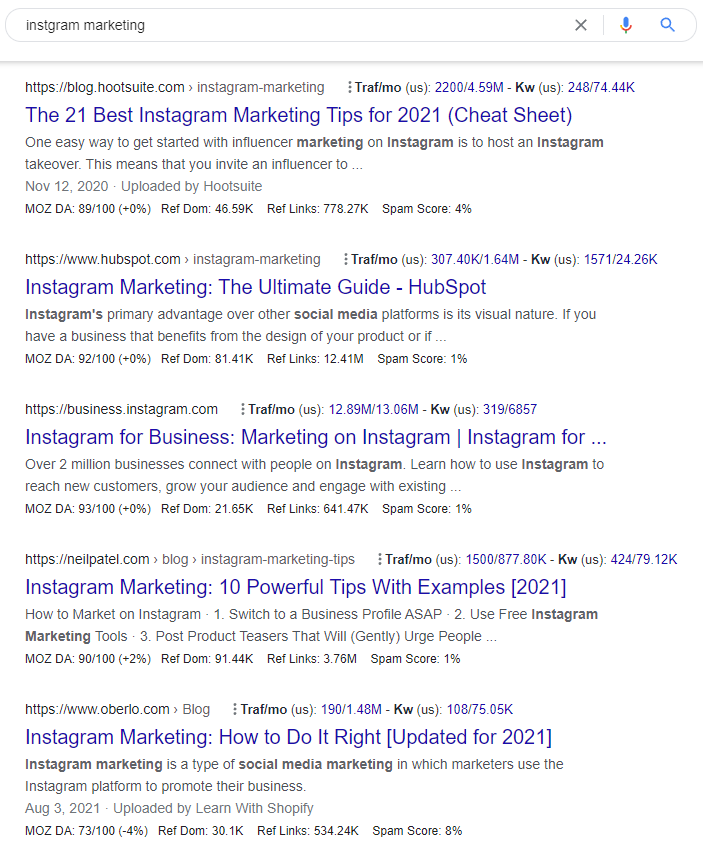
On the other hand, if we Google “sneakers” we get lots of results where we can buy them. As the result, Google predicts that people looking for this term are already in the mood of buying. As the result, their user intent is to buy rather than to find information.
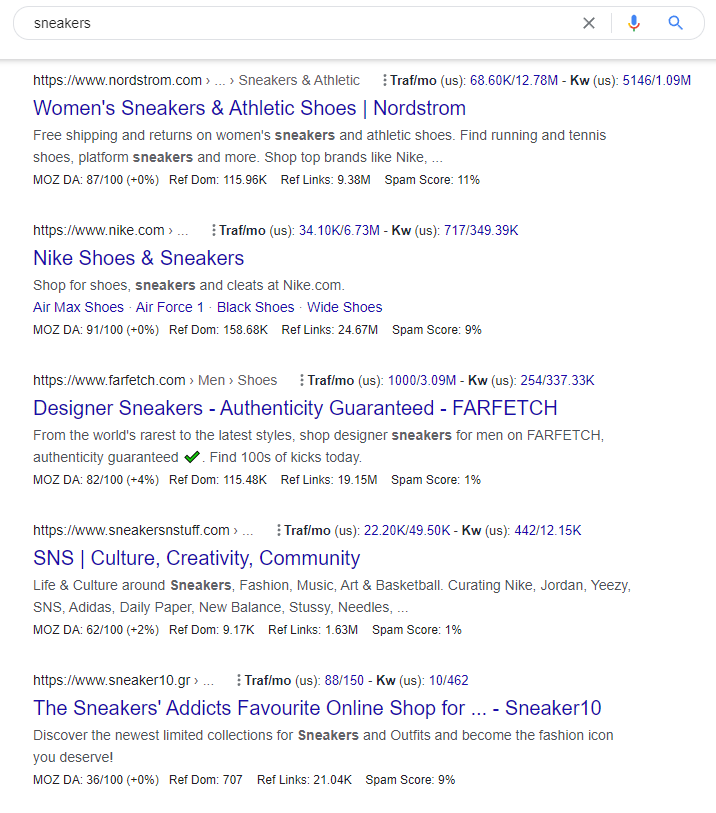
Keyword Research
Before building your website it’s important to understand your audience, their needs, and how to attract them. Keyword research helps to do exactly that and optimize your pages with search terms that people will use to find your business.
Before doing keyword research, keep in mind the following components:
- Search volume – shows how much people are looking for the particular term
- Competition – shows how hard it will be to compete for the following keyword
- Relevancy – tells how relevant the following term is to your business and what you do
In addition, it’s important to build a strong keyword research strategy. As the result, if you’re just started your business, avoid competing for the broad terms. Better known as head terms, and usually the biggest brands compete for them. The problem is that you don’t have enough resources to compete against them and it would take years to overtake these positions.
For example, “apple pie recipe” on Google returns 133,000,000 search results. This means we’ll have to compete against all these websites to get on the first pages of Google. And that would take years to get meaningful results.

So what’s the solution?
We should target long-tail keywords. The following terms aren’t that popular to compete with and are made from multiple words.
In addition, they have lower search volume than head keywords, are less competitive, and are easier to rank for the top positions.
For example, targeting “traditional apple pie recipe with a crumb topping and peanut butter” gives fewer results than the broad term and returns 7,100,000 results. In this case, we have better chances to rank higher.

Lastly, choose your keyword strategy wisely, don’t go full-in on broad terms, though don’t ignore them either. Otherwise, you might lose a good amount of traffic. And if you want to know more about how to begin your keyword researching strategy, check our latest article The Ultimate Guide to Keyword Research for SEO.
(Broad keywords VS Long-tail keywords | Vertical Rail Blog)
Title Tags
Title tags appear on the search engine results. And they’re headlines briefly explaining your page within 50 to 60 words.
It’s very important to create catchy title tags to get more clicks. However, be careful and don’t overpromise what people will find on your site.
Title tags influence other important metrics, such as Click-through-rate (CTR). As the result, if you want to get most of your headlines, include keywords and make them tempting to click.
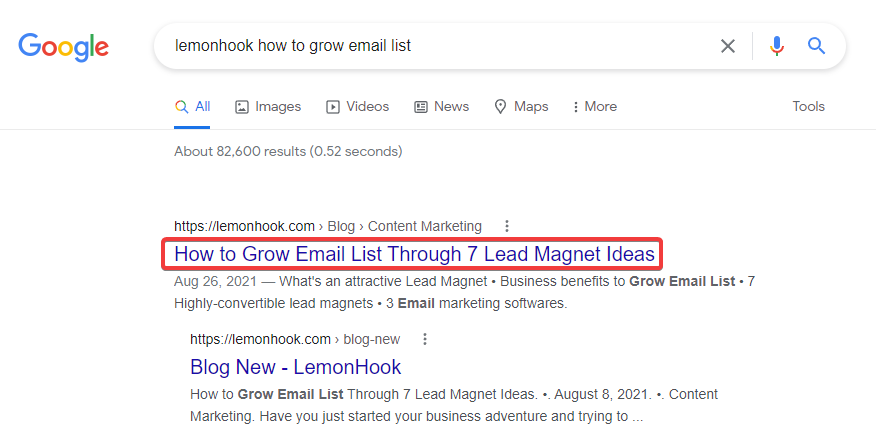
Header Tags
Next to title tags, you should think about optimizing your headings structure on the site.
Good SEO optimization practices claim that every page should have only one H1 header tag. Otherwise, it’ll confuse Google to understand the topic of your site and rank your content correctly.
In addition, after the H1 header title, use H2-H6 subheaders to structure your content on deeper levels. Helping search engines to better understand your website. Also, that’ll help skimmer readers to go through your text faster.
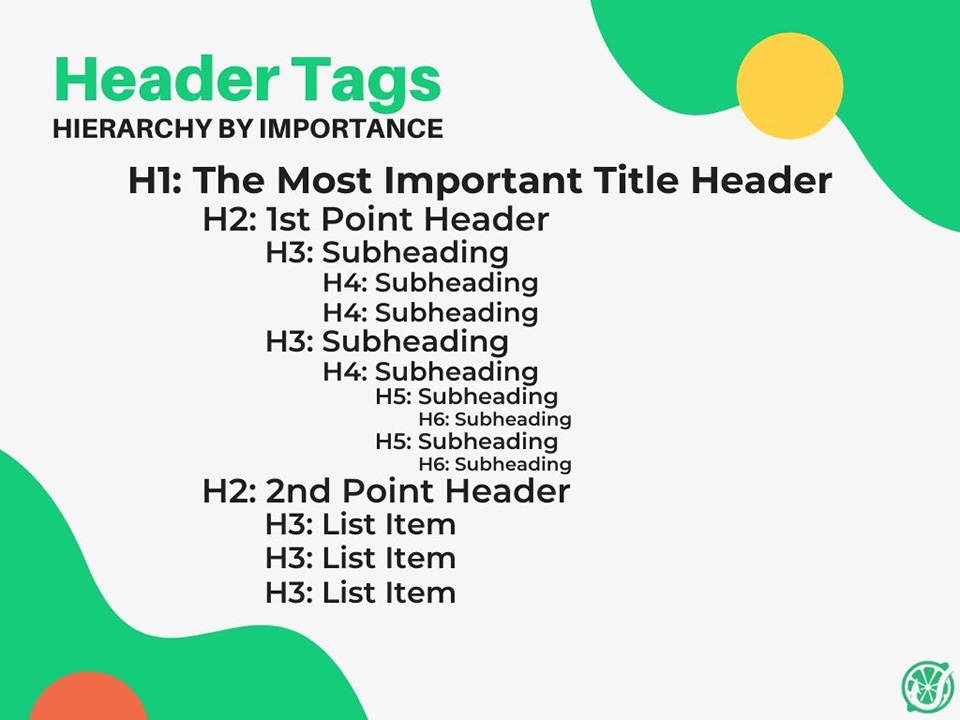
Meta Descriptions
Meta descriptions are short texts below your title tag that provides more information on what your customers can expect on your site. Therefore, don’t forget to include your keywords and make your meta descriptions display well both on mobile and desktop without being cut off.

Site Structure
Every site should have a clear structure and it plays an important role in SEO optimization. As the result, every website should have a clear structure that it’s easy to navigate both for humans and Google spiders.
The best practice is to keep your navigation so clear that once a customer lands on the homepage, any other page would be reachable in less than 3 clicks.
Site structure goes hand in hand with URL structure and has to supplement each other. Meaning it should allow Google spiders to go through your site without any troubles while clearly understanding its topic.
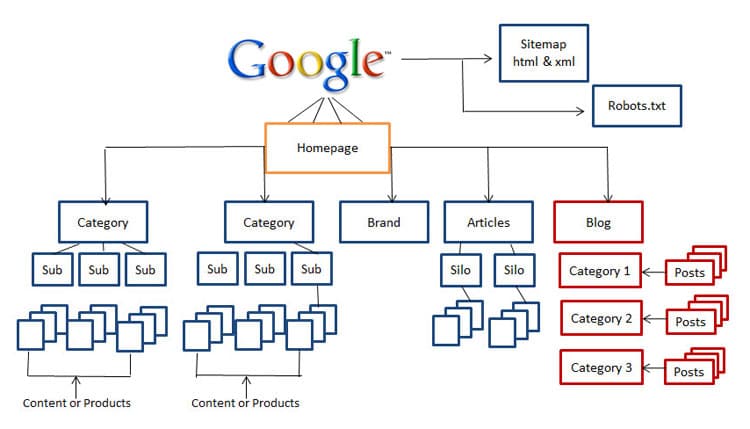
(Site structure mind map | OnwardSEO Blog)
URL Structure
URL stands for Uniform Resource Locator and consists of text phrases that lead to your website.
Optimize them logically, because Google looks at them to define what the page will be about. Therefore include your keywords, and make them as clear as possible to understand from a first glance.
Otherwise poorly optimized URLs can get lower click-through rates resulting in lower-ranking positions.
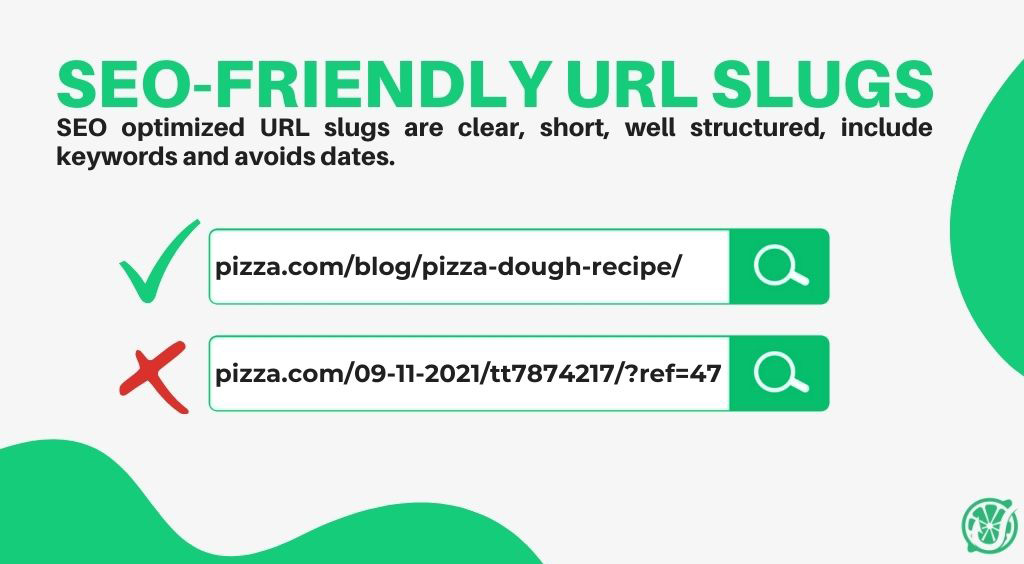
Off-Page SEO
Different from On-page SEO, Off-page SEO is responsible for less visual optimizations on your site and it’s more responsible for building the website’s authority, relationships with other brands, and raising brand awareness across the web.
Link Building
From the early days when Google was still a small company, its algorithm to rank websites was simpler than it’s now. To understand every website’s value, the number of backlinks coming to your site was tracked.
In short, they’re link connections pointing from one domain to another, and the link pointing to another site is called “Outbound-link”, and the receiving one “Inbound-link”.
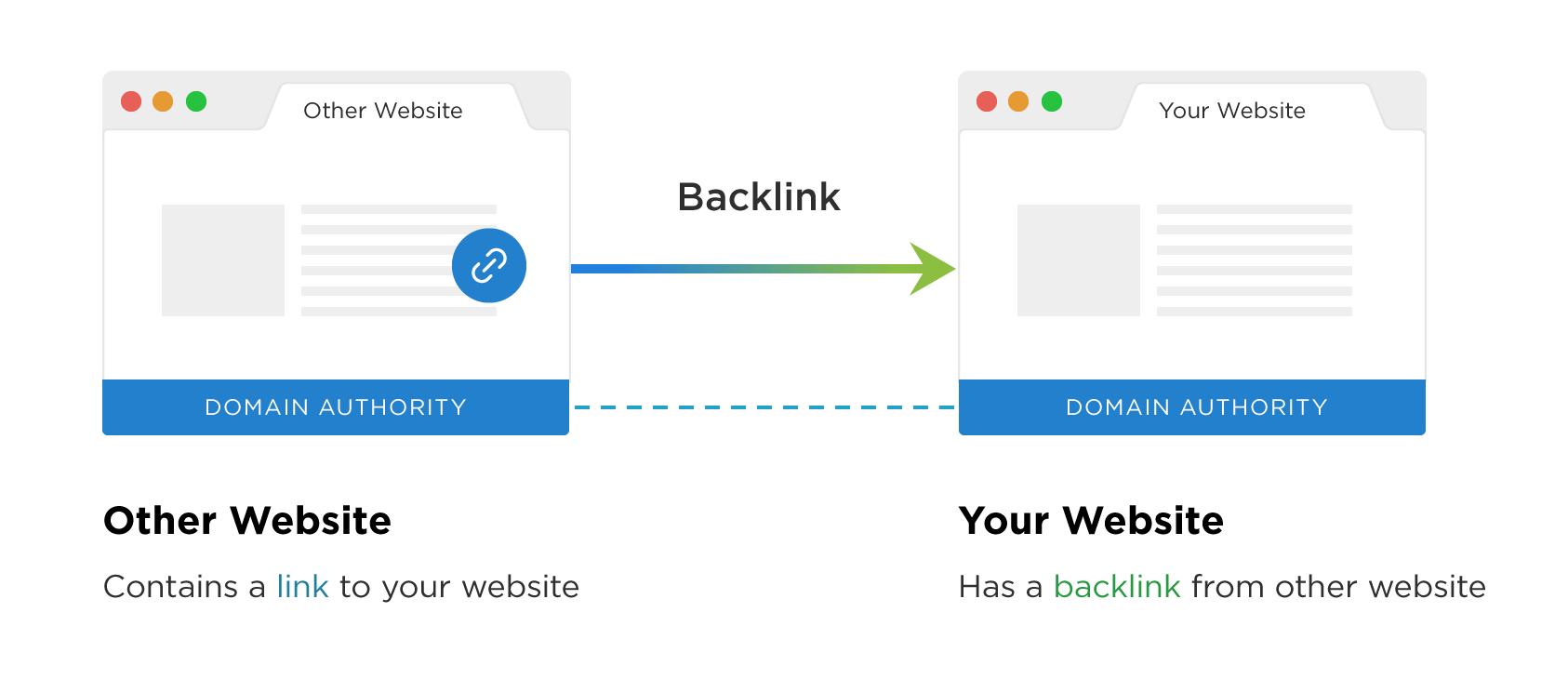
(Backlink explanation| Backlinko Blog)
To build quality links, keep in mind the following characteristics:
- Relevance – build link connections relevant to your business and the industry you operate in. Hence if you’re a gaming studio you want to get links from news sites writing about your industry rather than politics
- Domain Authority – defines website’s relevance for a specific subject or industry. As the result, you always want to connect with websites having stronger domain authority than yours
- Traffic – aim for quality links that have bigger monthly traffic, otherwise, connections to poor-performing sites can be ignored and won’t add much to your overall ranking
Back in the days, the formula was simple, the more links you’ve got, the more important your business was seen by Google. As a result, many shady websites got higher ranking positions on Google.
Other bad techniques such as buying/selling links, or placing your websites on the low profile link directories were born.
That didn’t last long before Google noticed and started penalizing sites abusing it. As the result, they’ve constantly updated algorithms with new rules punishing all the abusive link-building practices that aimed to gain spammy links that didn’t add much value to the site.
That’s how white and black hat SEO techniques were born that defined what link-building practices are encouraged and which ones should be stopped.
In short, avoid buying links or placing them on low-quality directories. And if you want to build quality links you’ll have to put some legwork to make it happen. Guest blogging, creating 10 times better quality content, and in-house infographics creation are just a few examples.
Though, if you want to learn more about link-building and how to create quality links check our blog post about Link Building. Here we share the best link-building practices and how to create a winning strategy that works.
(Link building strategies | Umbrella Consultants Blog)
Brand Awareness
Optimizing your Off-page SEO is like actively trying to raise your brand awarness. That’s actively reaching out to other companies, doing PR activities, and spreading your brand message.
Actively doing PR campaigns such as reaching out to media sites, asking for collaborations, and being featured on similar content sites requires energy. However, all this pays off in the quality links and built long-lasting partnerships.
SEO Success Metrics
As Peter Ducker said, “What gets measured get managed.” That applies very well to other SEO optimization practices too. After all, you don’t want to keep changing things on your site without understanding how well they perform.
So you might ask, what metrics should you track and how to do it?
Website Traffic
Well, probably one of the most common and easiest ways to track your performance is following your website’s traffic. For instance, if your monthly traffic before optimizations was 1,000 and after the update, it doubled, it means to keep doing what you do, because that works.
If you’re a Google Analytics user, you can easily find the traffic sources within the Reports section.
Reports > Acquisition > Traffic acquisition
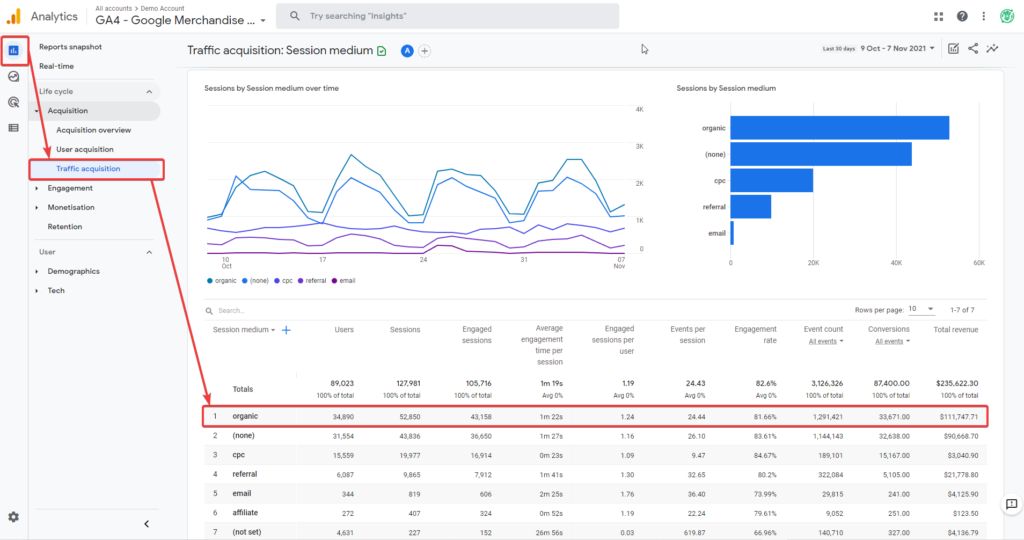
Conversions Tracking
Traffic to your website is worthless if you don’t generate conversions or haven’t defined what a single conversion means to your business. In other words, conversions are desired actions performed on your website that are beneficial to your brand.
These could be purchases, newsletter signups, link clicks, and many other sets of actions.
If you’re using Google Analytics you can easily track conversions and see how many people performed your desired actions in the Configure section.
Configure > Conversions
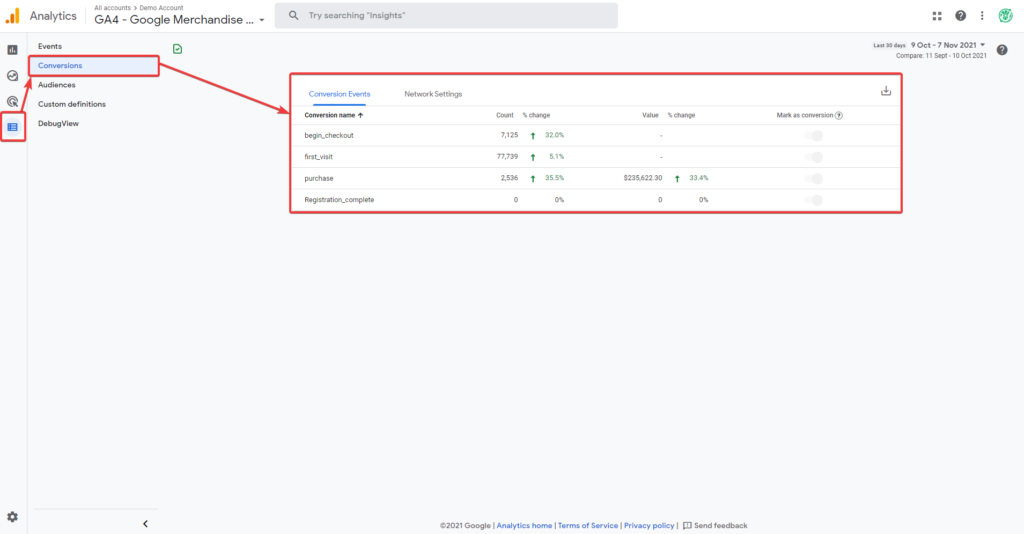
Bonus Point
SEO Tools
Many professional SEO tools cost money, and it might be that’s not needed for you yet if you just started in SEO. Therefore in our Bonus part, we share our top Free SEO tools for beginners to get started working with your optimizations.
Keyword Research
GOOGLE KEYWORD PLANNER
A great tool to find targeted keywords, that shows the average monthly traffic and costs per targeting. The only downside here is that you have to have an active campaign if you want to see more precise monthly traffic. Otherwise, you’ll get only rough numbers.
GOOGLE TRENDS
Free tool to spot trending topics and compare them to other regions. It’s a great research tool for content creation on your site and studying what your audience is interested in.
AHREFs KEYWORD DIFFICULTY CHECKER
Find out how difficult it’ll be to compete for the particular keywords, and sort them by difficulty.
UBERSUGGEST
This is a great keyword research tool that shows all the stats you need to know about each keyword and its competitiveness. Including search volume, SEO difficulty, and CPC costs.
Though keep in mind that you only get 3 free daily searches and if you want to continue you have to sign up. Otherwise, come back each day to get more free credits.
On-Page SEO tools
YOAST SEO
If you’re a WordPress user it’s a must-have tool that’ll ease your SEO optimization work. It’s free and gives various optimization suggestions such as text readability, keyword density, linking, metadata, and other SEO recommendations.
Link building tools
AHREFS BACKLINK CHECKER
Try Ahref’s free backlinks checker that will show you a glimpse of the top 100 backlinks referring to the website and their stats such as domain authority.
SEO SPYGLASS
Research your competitor’s link-building strategy from the ground up. It provides up to 1,100 backlinks per domain and unlimited domain checks for free. Analyze parameters such as linked pages, anchor text, dofollow, and nofollow attributes, domain authority, and how spammy the domains are.
GMAIL
Sometimes you don’t need fancy tools to do the job done.
Back in 1960, the USA NASA department spent thousands of dollars re-inventing the pen that perfectly worked in space conditions. On the other hand, the Soviets just simply used pencils and saved so many resources on the space program.
The lesson is, sometimes you don’t have to re-invent the wheel to do the job done. And for example for email outreach campaigns, you don’t have to use any fancy tool, just use Gmail.
Technical SEO tools
GOOGLE SEARCH CONSOLE
Webmasters use this tool to troubleshoot websites, fix indexing errors, speed issues, mobile usability errors, and much more.
GOOGLE ANALYTICS
This tool should be every SEO specialist’s meat and bones for measuring the campaign’s success. It allows you to check your website’s performance, understands traffic sources, events, conversions, demographics, and devices people use to visit your site.
Conclusion
To sum up, each website should care to optimize its SEO, if you want to generate more traffic, leads, and sales without spending a fortune. And it’s beneficial for several reasons:
- It brings 24/7 traffic
- Generates free brand awareness
- Helps to get higher positions on search engines
- Builds trust
Though SEO optimizations aren’t an overnight success and you’ll have to put in work and plan it appropriately.
In the end, SEO optimization is a long-term strategy, and getting positive results will take time.
Before starting learning SEO, learn about search engines and how they work. The basics of crawling and indexing, how your page is ranked, and why your website should have sitemaps.
Once you get good at it, there’re several SEO optimization methods you should know.
On-Page SEO includes the process of optimizing visual elements on your site that allows Google spiders to better understand your content.
These include optimizing:
- Search Intent
- Keyword Research
- Title Tags
- Header Tags
- Meta Descriptions
- Site & URL Structure
On the other hand, Off-Page SEO is responsible for fewer visual elements on your site and it’s for building relationships with other brands, growing the site’s authority, and raising brand awareness across the web.
As the result it includes:
- Link-building
- Brand Awareness
Lastly, how do you know if your optimizations work if you don’t track your results?
Therefore, it’s a must at least to track basic metrics such as monthly website traffic and the number of conversions. That will help to understand if your SEO campaigns work and what you should change.
To become good at SEO you’ll have to put time and effort, many trials and errors to understand what works and what doesn’t. If you wish to save a few years of hassle and avoid making some mistakes, check out this book on SEO and how to rank on the top of Google pages written and constantly updated by SEO expert and founder of Exposure Ninja Tim Cameron-Kitchen.
In this book, you’ll increase your knowledge on SEO fundamentals, learn how to analyze your website, and promote it even that the national newspapers would notice.
And most importantly how to create a winning SEO strategy that works and brings long-term results, regardless of all the new updates Google throws at you.


